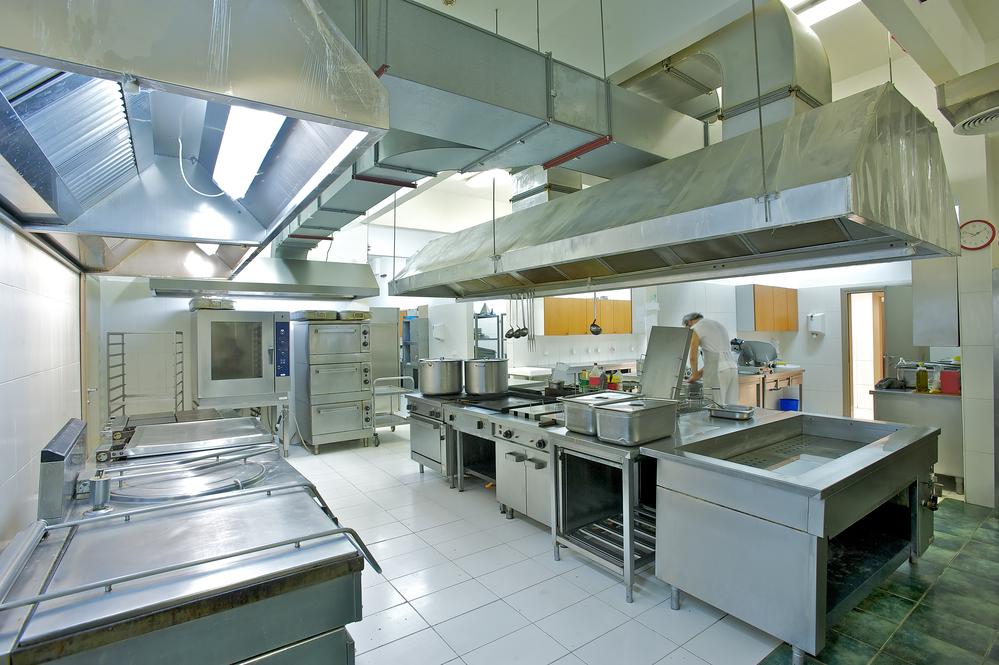Those who have spent years working in the restaurant industry know that it’s challenging to maintain a stable temperature in a hot kitchen. Food preparation equipment tends to produce a lot of heat in a small area, which can overburden even the most robust restaurant kitchen air conditioning systems. The perfect time to anticipate this burden is when you’re setting up your restaurant kitchen, as you can plan system location and strength before it becomes a problem. In the worst case, a failure to properly anticipate your kitchen’s air conditioning needs can cause your employees to suffer fatigue and heat exhaustion when your restaurant is depending on them the most. To help restaurants plan for this possibility, we’ve assembled a list of the top five considerations for restaurants when installing or upgrading their kitchen air conditioning.
What to Keep in Mind When Installing and Maintaining a Restaurant Kitchen Air Conditioning System
Equipment Location
When you’re installing your system, it’s essential that you plan for where you’ll install your kitchen equipment. Installations such as flat-top grills, salamander ovens, gas ranges, and dishwashing stations are often difficult or impossible to move from their locations. As a result, restaurant kitchen air conditioning exhaust vents and intakes must be placed in locations that have some access to the room. If you don’t consider these locations in advance, then you may be forced to adjust your kitchen layout in a way that makes it more difficult for your team to work efficiently.
your kitchen equipment. Installations such as flat-top grills, salamander ovens, gas ranges, and dishwashing stations are often difficult or impossible to move from their locations. As a result, restaurant kitchen air conditioning exhaust vents and intakes must be placed in locations that have some access to the room. If you don’t consider these locations in advance, then you may be forced to adjust your kitchen layout in a way that makes it more difficult for your team to work efficiently.
The Heat from Equipment
There’s a substantial difference between your cooling dining room and cooling the kitchen. Without adequate ventilation and cooling, your restaurant kitchen’s temperature can easily exceed 100 degrees. If your workers must complete their shifts in an excessively hot environment, it can decrease their effectiveness, increase mistakes, reduce morale, and potentially endanger their health. These risks are compounded if you regularly schedule your kitchen staff for double shifts on your restaurant’s busiest days. You must pay special attention to the areas of your kitchen directly around the hottest equipment, such as stoves, grills, and ovens. These areas can become far hotter than the kitchen’s average temperature.
Supplementary Cooling Systems
Many restaurants avoid air conditioning system difficulties by supplementing their central HVAC system with smaller units dedicated to combating kitchen heat. One common solution is to install one or more box split air conditioners in the hottest parts of the kitchen. These systems should be on a separate circuit from your main system and disconnected from the primary thermostat. By giving your kitchen staff and restaurant management team control over these supplementary cooling systems, you can give them the tools to regulate the kitchen’s temperature better.
Grease Filters and System Cleaning
Aside from the temperature, you must also consider air quality within your kitchen. While grease levels in the air vary depending on the type of cuisine and where your fryers and grills are, few areas struggle with air pollutants more than the kitchen. You are more likely to need ongoing vent cleaning in the kitchen and should regularly review how dirty your filters have become. We suggest working this check into a biweekly or monthly cleaning maintenance schedule, as fluctuations in customer attendance and special event frequency may have a significant impact on air quality. You should also consult your municipal regulations, as many cities mandate that certain equipment must be located beneath grease-catching hoods. These hoods often require additional ventilation that must be maintained separately from your standard HVAC vents.
Electrical Wiring
As we alluded to with the supplementary cooling systems, your kitchen may require additional electrical wiring to ensure that your equipment doesn’t overload your system. Your kitchen is likely to have multiple refrigerators, freezers, and prep equipment that each place a burden on your circuitry. Don’t get caught by surprise when it’s time to install your air conditioning system – you should anticipate the stress that multiple systems will place on your electrical wiring throughout your restaurant. Consult a licensed electrician before determining what air conditioning systems you’ll use, as you must balance how effective the system is against what your electrical capacity is. In general, you should always allow for more power to the kitchen than you think you’ll need at first, as your changing menu may necessitate additional equipment that further burdens your circuits.
Getting the Help You Need for Your Restaurant Kitchen Air Conditioning Systems
No two restaurant kitchens are identical, so each restaurant owner faces unique challenges when balancing their equipment needs against their employees’ comfort. The best way to keep these considerations in mind when planning your kitchen is to consult a reputable HVAC technician to assess your kitchen before installing your primary equipment. Any extra planning you conduct before your restaurant opens for business will significantly limit the complications you encounter during operation.
